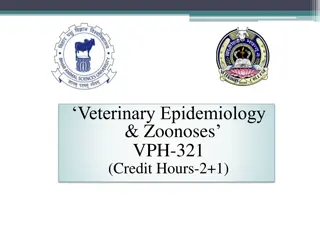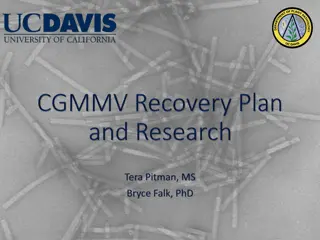Understanding Nipah Virus: A Comprehensive Overview
Nipah virus, belonging to the Paramyxoviridae family, is a zoonotic virus with high pathogenicity and mortality rates. It falls under the Henipavirus genus, known for infecting a wide range of animal species. Its virion structure consists of non-segmented, negative-sense RNA, and the viral genome contains 6 genes that code for 9 proteins crucial for replication and transcription. The virus replicates in the cytoplasm by binding to host receptors and utilizing RNA polymerase for transcription. Overall, Nipah virus poses significant challenges due to its biosafety level 4 classification and lack of specific treatment.
Download Presentation

Please find below an Image/Link to download the presentation.
The content on the website is provided AS IS for your information and personal use only. It may not be sold, licensed, or shared on other websites without obtaining consent from the author. Download presentation by click this link. If you encounter any issues during the download, it is possible that the publisher has removed the file from their server.
E N D
Presentation Transcript
Nipah Virus The Next Plague? Ramsha Kudia MCB5505
Taxonomy Family: Paramyxoviridae Subfamily Paramyxovirinae Genus Avulavirus Newcastle disease virus Genus Henipavirus Hendravirus Nipahvirus Genus Morbillivirus Measles virus Rinderpest virus Genus Respirovirus Sendai virus Human parainfluenza viruses 1 and 3, as well some of the viruses of the common cold Genus Rubulavirus Mumps virus Human parainfluenza viruses 2 and 4 Subfamily Pneumovirinae Bovine respiratory syncytial virus Human respiratory syncytial virus Murine pneumonia virus
Henipavirus Only zoonotic paramyxoviruses and are highly pathogenic Genome size 18.2 kb, about 15% larger than other family members Biosafety level 4 because of pathogenicity, high mortality, and lack of treatment The genus is able to infect a broad range of animal species, which is uncommon among the family High mutation rates
Virion Structure Non-segmented, negative sense, single stranded RNA Encapsulated Polymorphic, but usually spherical or filamentous Helical nucleocapsid
Viral Genome The genome contains 6 genes, which code for 9 proteins M = matrix protein organizes and maintains virion structure Leader sequence at 3 end and trailer at 5 end F = fusion protein Fusion requires a neutral pH N = nucleocapsid gene protects from nuclease digestion G = glycoprotein, attachment bind to sialic acid on the cell surface and facilitate cell entry P = phosphoprotein binds to the N and L proteins and forms part of the RNA polymerase complex the P gene utilizes multiple reading frames to make different accessory proteins, which are not essential for replication, but may aid in survival C protein regulates viral RNA synthesis and may be a virulence factor L = Large polymerase catalytic subunit of RNA dependent RNA polymerase
Replication and Transcription Replication occurs in cytoplasm The virus attaches to host surface receptors by G glycoprotein Envelope fuses with plasma membrane and the ribonucleocapsid is released into the cytoplasm viral RNA dependent RNA polymerase binds to the encapsidated genome at the leader region The polymerase sequentially transcribes each genes by recognizing start and stop signals flanking viral genes mRNAs are capped and polyadenylated by the L protein during synthesis Replication starts when there is enough nucleoprotein to encapsidate the new virion Matrix proteins line the cytoplasmic side of the plasma membrane The ribonucleocapsid interacts with the matrix protein and buds off, obtaining its envelope from the plasma membrane
History The virus was first discovered in 1999 in Malaysia There have been 12 outbreaks since then Named after city When the disease first appeared, people thought it was Japanese Encephalitis (JE) Authorities spent 5 months vaccinating people against JE and killing mosquitoes, which was a waste of time There were features that made it different from JE; for example, it infected adults more often then children There was also a disease in pigs going around Some believed it was related to Hendravirus When the disease spread out of Ipoh, it was discovered the pigs were transmitting disease After determining cause, 1,000,000 pigs were shot and buried, destroying half the country's pig market Found that one of the original locations of the outbreak in pigs was near the forest where there were fruit bats The farm was also surrounded by fruit trees, which offered food for bats Pigs had been infected by bats, which caused a problem because pigs could be stopped from crossing borders, but bats could not
geographic distribution of Nipah virus overlaps with that of Pteropus genus of bats
Animal Pathology Most pigs suffered from respiratory illness, while neurological symptoms were less common Nipah outbreaks in pigs and other domestic animals (horses, goats, sheep, cats and dogs) were first reported during the initial Malaysian outbreak in 1999 Many pigs had no symptoms, but others developed acute feverish illness, labored breathing, and neurological symptoms such as trembling, twitching and muscle spasms Generally, mortality was low except in young piglet The incubation time for pigs 4-14 days Pigs are infectious during incubation Pigs spread disease by coughing
Natural Host Predominately family Pteropodidae fruit bats 10 genera and 23 species of bats in a large part of Asia and Africa aggregate with a density of more than 3,000 bats/m2, in population of up to several million individual animals long distance flyers, with some species travelling up to 640 km during seasonal migration Migratory bats have been shown to exchange novel viruses with non-migratory ones
Geographic distribution of seropositive bats is growing
Pathogenesis in Humans Targets microvascular endothelial cells At autopsy, microscopic evaluation revealed widespread vasculitis, endothelial cell destruction and focal perivascular necrosis in small vessels in the lung, heart, an kidney with the most severe damage observed in the vessels of the CNS Microvasucular blood vessels of several organs exhibit syncytia or multinucleated giant endothelial cells, accompanied by vascular inflammation Not a feature of other viral encephalides Greatest viral load seen in the CNS
Symptoms Incubation 4-18 days The onset of symptoms ranged from 24 hours to 1 month Symptomatic to nonsymptomatic ratio 3:1 Some symptoms similar to influenza Fever Muscle pain Headache Pneumonia and systemic infection in rare cases Seizures, abnormal pupillary reflexes, absent doll's eye reflex, profound tachycardia, hypertension, tremor, dysarthria Reduced level of consciousness Inflammation of brain Disorientation Coma Encephalitis can be acute or late onset Acute can result in relapse
Transmission Bat-to-pig Half-eaten fruit from bats Pig-to-many animals Direct contact or by aerosols Pig-to-human From direct contact with pigs Bat-to-human Humans eating fruit with bat saliva Bat urine, feces, saliva Human-to-human Possibly through aerosol Contamination with human excretions Spread in healthcare settings
Diagnosis serum neutralization enzyme-linked immunosorbent assay (ELISA) polymerase chain reaction (PCR) assay immunofluorescence assay virus isolation by cell culture
Epidemiology There have been outbreaks almost every year since it was discovered Is a problem in Bangladesh
Outbreaks in of the Nipah Virus have seasonal pattern in South Asia Limited geographical distribution Transmission in Bangladesh also showed human-to- human transmission
Current Nipah Virus Outbreak Bangladesh Bans Sale of Palm Sap After an Unusually Lethal Outbreak By DONALD G. McNEIL Jr. Published: March 21, 2011 Bangladesh is suffering an outbreak of deadly Nipah virus, causing the government to adopt an unusual prevention tactic: a ban on the sale of fresh palm sap. The virus, carried by bats, was identified only in 1999. It causes dangerous brain inflammation in humans and is infectious. The Bangladeshi outbreak is unusually lethal, killing 35 of the 40 people known to have been infected. The first known outbreak of Nipah virus was in Malaysia, where most victims raised or butchered pigs that were the source of infection. The pigs are believed to have rooted beneath bat colonies in trees, eating food contaminated by droppings. But the Bangladesh outbreak happened without a swine vector. Bangladeshis like drinking date palm sap, which is gathered in a way similar to maple syrup collection, said Dr. Jonathan H. Epstein, a veterinarian with the EcoHealth Alliance, which is helping Bangladesh track the virus. Gatherers called gachis climb high into the trees, shave the bark with machetes and hang clay pots on the trunks to collect the sap at night. Large fruit bats called Indian flying foxes are attracted and lap up the running sap, sometimes fouling the pots with their saliva, urine or feces. Many people in the tropics leave palm sap to ferment into wine and fermentation might kill the virus. But most Bangladeshis are Muslim, and do not drink alcohol, Dr. Epstein said. The government health agency is also trying to persuade the gachis to put what he called bamboo skirts over the mouths of their collecting jars. The gachis like them, he said. They keep the stuff pure, so they can sell it for more.
Prevention and Treatment Pig farmers should quarantine suspected animals and avoid direct contact The virus can easily be killed with bleach or detergents like sodium hypochorite Fruit should be washed and peeled before consumption Boil date palm oil Avoid contact with infected humans as it is possible to be infected by aerosols There is no vaccine or treatment for Nipah Virus Treatment is mostly focused on managing fever and the neurological symptoms Ribavarin is used to treat symptoms such as nausea, vomiting, and convulsions Vaccine is being developed Recombinant sub-unit vaccine formulation protects against lethal Nipah virus in cats
Potential For Bioterrorism Cause fear and panic No effective treatment Economic loss Can spread through aerosols or food
References Fong, I. W., and Ken Alibek. New and Evolving Infections of the 21st Century. New York, NY: Springer, 2007. 279-93. Hsu, V. "Nipah and Hendra Viruses." Perspectives in Medical Virology 16 (2006): 179-99. Knipe, David M. "Fields Virology by David M Knipe and Peter M Howley | Free EBooks Download - EBOOKEE!" Web. Apr. 2011. Strauss, James H., and Ellen G. Strauss. Viruses and Human Disease. San Diego: Academic, 2002. 147-55. Tabor, Edward. Emerging Viruses in Human Populations. Amsterdam: Elsevier, 2007. 179-94. "ViralZone: Henipavirus." ExPASy Proteomics Server. Web. Apr. 2011. <http://expasy.org/viralzone/all_by_species/85.html>. "WHO | Nipah Virus (NiV) Infection." Web. Apr. 2011. <http://www.who.int/csr/disease/nipah/en/index.html>. "WHO | Nipah Virus." Web. Apr. 2011. <http://www.who.int/mediacentre/factsheets/fs262/en/>. Wolf, Mike C., Oscar A. Negrete, and Benhur Lee. "Pathobiology of Henipavirus Entry: Insights into Therapeutic Strategies." Future Virology 2.3 (2007): 267-82.























